History of St Andrews
The Following is taken from the short guide of the church leaflet
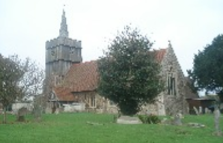
Welcome
A short guide to the history of St Andrew’s
You are standing by the south door in the nave the oldest part of the building dating from about 1120. If you step back into the porch, you will note the thickness of the walls and the inclusion of Roman bricks from an unknown local villa and a reddish brown material known as septaria – a mudstone dredged from the River Colne. The timber lintel through the Romanesque arch was dendro dated as being about 1120. It is thought the building maybe be on a Roman site.

It is believed that the porch dates from 1550. In the wall to the right of the church door is a recess known as aholy water stoop. Return into the building and proceed to the right.
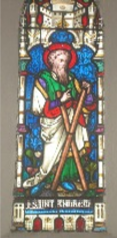
On the south wall of the nave is the only remaining original window with later glass depicting St Andrew. When you walk through the arch you pass into the Chancel that traditionally was more reserved for the clergy. It is believed to have been built circa 1350. In the south wall is a piscine that was used for cleansing the chalice a deep red colour, and we found the 1360 ledger slab.
The work greatly improved access by removing seven different floor levels, so we now have a very flexible building. The opportunity was also taken to install under floor heating and better lighting. The majority of the cost being raised by donations from Church members. We do hope you have enjoyed your visit and please feel free to take away this leaflet as a memory of it.
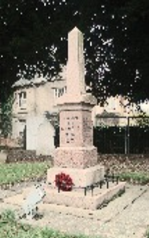
Leaving the Church you will note the war memorial to the right of the path. This was moved from near the shops several years ago. The large house to the right was the original Church Farm and the Rectory from 1952. The new Rectory is in the rear garden and was completed in 2012. The bricks came from Colliers Brickworks at the end of the lane.
Passing through the pathway arch you leave the original churchyard onto what was once Church Green. A new area of graveyard is being added to the left.. Church Lane was previously further to the east and moved because of the railway around 1842.
Please free to walk around the grounds or to just sit and meditate either inside or on one of the benches in the churchyard. A Bible is available for you to use
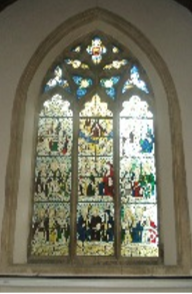
The large east window designed by George Daniels was installed in 1925. The subject is worship suggested by the Te Deum – part of the liturgy of the old Prayer Book. You will note the figure of Charles 1. For a more detailed description, click here. On the floor in the far left corner is a ledger slab that originally had a brass plaque indicating that it was in memory of Robert and Katerine de Teye who seem to have both died in October 1360 on the same day. They may have paid for the chancel. In the centre of the Chancel is theAltaror Holy Table used for the sacrament of Holy Communion when we remember the Last Supper. In the week we have a simple wooden cross on display. Christianity and the reason for this glorious building is based on the resurrection of Jesus after dying on the cross and the difference this has made to those in the past and to us today.
In the centre of the Chancel are 3 dark slabs covering the burial positions of former rector William Bree and his 2 wives. In his time the church was restored and a rectory built. On the north wall near the Chancel arch is a small wooden door giving access to narrow stairs within the wall that originally led onto a stonerood screen that separated the 2 parts of the church. We do not know when this feature was lost.
The north door gives access to the Church Hall built in 1967/8 as a replacement for a hall demolished by the dualling of the A12 trunk road. The hall, incorporating toilets and a kitchen, is well used by the local community. You are welcome to borrow any material from the bookcase on the north wall.
The tower has been built at various stages and is unusual in being half timbered. Access into the tower is through the locked door and a narrow staircase. Apparently there were originally three bells but now only one bell dated 1772, remains. The tower is 18m/60’ tall.
The base of the tower dates from the early fifteenth century. A local legend is, that the top half of the tower had to be rebuilt after being used as gunnery practice by soldiers besieging Colchester (1648) in the Civil War. The truth of this has not been proven. Nevertheless it is a remarkable wooden structure with 250mm square and 9m long corner posts – an amazing engineering feat. The cladding boards are elm. The oak shingles to the spire were last replaced as a result of second war bomb blast damage.
In the tower there are plaques in memory of those who died in both World Wars. The notice boards give details of some of the organisations we support. The oakchest is early sixteenth century.
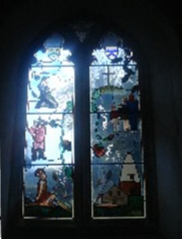
The modern stained glass window by Auravision, installed in celebration of the millennium, depicts scenes reflecting the history of the village over 2000 years. An explanatory leaflet should be visible to you. The scripture ‘Jesus Christ, the same yesterday, today and tomorrow’ is from the Book of Hebrews
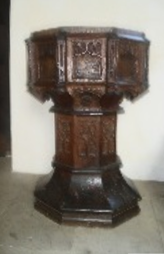
The wooden font is very unusual, and it is reputed that this is the only one of its type in the country. It dates from the fifteenth century and carved figures in the panels were removed in the Cromwellian period. The font is used for baptisms, an important part of the initial welcome into the Christian life.
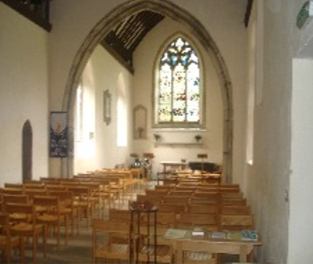
During the work we learnt that the nave originally had a rounded apse end, that at one stage the walls were painted
The building was re-ordered in 2006/7 returning it to a more simple space that honours it’s medieval origins. Several centuries would have passed before seating and pews were introduced.
